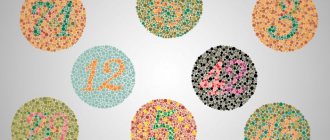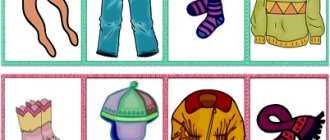How to learn colors with your child
Tips for parents:
- You can start learning colors as early as a year, but children will be able to distinguish and remember only after reaching 2-3 years of age, when an active cognitive interest appears.
- At the beginning of getting acquainted with colors, focus the child’s attention on the main ones - yellow, blue, red and green. Gradually add new colors. Do not start introducing the next color until the baby begins to confidently name the previous one.
- Draw analogies - a red pencil, a red car, a red ball - so that the child does not associate the color with only one object.
- Don’t distort the words, don’t say that the toy is “yellow” - it is yellow.
- For children, training should be carried out in a playful way, changing activities at the first signs of fatigue.
- Teach your child to distinguish colors through creativity using paints, colored paper, plasticine and pencils. We recommend the “cleanest” and simplest way of drawing for kids.
Drawing Method
Many teachers recommend a proven method for teaching a child colors - drawing. During the third and fourth years of life, the baby enjoys trying to draw with both colored pencils and paints.
For kids, the drawing procedure brings a lot of positive emotions, develops visual perception and memory. It is worth remembering that praise can be an excellent stimulant in the learning process.
Take an active part in depicting animals, birds or landscapes. Invite your little one to decorate, for example, a tree with a green pencil.
At an unobtrusive request from an adult, a child of the third or fourth year will definitely go to the meeting and try to complete the task assigned to him. When the drawing is ready, praise your child for his efforts, try to count how many colors were used to create the image. In just a short period of time you will be able to learn the basic 6-7 shades.
The learning process for children while drawing goes quite quickly. A 2-3 year old child will be able to learn colors quite simply and without any difficulties, all he has to do is regularly reinforce the material he has learned.
Educational games for learning colors
Color sorting games
With the help of sorting, the child will learn to identify objects by color and divide them into groups. Parents will be required to voice the colors so that the baby remembers them. What can you sort? Here are a few educational games that you can easily make with your own hands:
Game "Colored Cars"
Source: thrive360living.com
Necessary materials:
- colored cardboard;
- wooden wheels for toys or large colored buttons:
- template of a car or other vehicle with wheels;
- felt-tip pen;
- scissors.
How to do
Line A4 cardboard into four equal parts and cut off 1/4 of each sheet. Draw the cars using a stencil.
Coat the wooden wheels with acrylic paint and let dry. Select shades of paint so that the colors of the wheels match the colors of the cardboard.
How to play
Place colored cards and wheels in random order in front of the child. Invite your child to choose the wheels by color and sort them into pictures. Comment on his actions, name the colors.
This game is suitable for both home and outdoor use. Use a hole punch to make holes in the cards and secure them with ribbon or a ring. Place the wheels in a bag. Take the game with you to a cafe or clinic. The game will help keep your child occupied for a while.
Game with plasticine “Learning shapes and colors”
The game helps to learn colors and shapes, develops fine motor skills, and teaches counting. Will interest children from one to three years old.
Source: www.notimeforflashcards.com
Necessary materials:
- Play-doh plasticine of different colors (in My-Shop) or make colored salt dough (recipe here);
- multi-colored curly buttons corresponding to the colors of plasticine.
How to play
We chose 6 colors of plasticine: red, orange, yellow, green, blue and purple.
Place 1/2 of a jar of each color of plasticine on the table. Place a container with colored parts nearby.
Invite your child to play, explain and show how to sort by color.
When your child begins the lesson, comment on the actions, naming colors and shapes. For example, with such phrases: “We put a blue star on blue plasticine.”
When you are finished sorting, count the number of items of each color.
Sorting game "Monsters"
Make your own educational game for kids to sort by color and construct simple objects. The game promotes learning colors and counting, develops fine motor skills and logical thinking.
Source: toddlerapproved.com
Necessary materials:
- designer Lego Duplo (in My-Shop);
- brown paper bags or boxes;
- scissors:
- glue;
- colored cardboard;
- markers;
- doll eyes (in My-Shop, Aliexpress)
How to do
Cut out monster bodies from colored cardboard and glue them onto paper bags. Add shape and stability to each item by folding the top edges of the bag outward. Make cuts in the mouth area. The resulting hole should be slightly larger than the Lego blocks. Draw faces on the monsters with felt-tip pens and glue on the eyes. Monsters are ready to eat!
How to play
Place the monsters near the child and place colored Lego Duplo pieces in front of him. Tell your child that the monsters are hungry and need to be fed. Everyone loves food that has a matching color.
After sorting by color, invite your child to choose his favorite color, count the number of blocks in the bag and create a design from them. Be sure to praise your child for the work done!
Sorting Colored Stickers
Kids love to put on stickers. This activity is useful for improving fine motor skills. You can also study colors using color stickers (Aliexpress, My-Shop).
Source: busytoddler.com
We sort colored pom-poms (My-shop, Aliexpress), buttons, mosaics, small toys.
Source: munchkinsandmoms.com
Source: gluedtomycraft.com
Source: supermom.ru
Source: supermom.ru
Looking for a couple
For example, look for a pair of multi-colored socks or felt-tip pens for their caps.
Source: supermom.ru
Color lotto
A small lotto from Lisa Chernikova (download here), where the child has two tasks at once - to determine the color and to identify the object.
Source: supermom.ru
Games for learning shades
Palette cards from the paint department of a hardware store are a great tool for teaching your child about color shades.
Using them you can quickly learn the concepts of “dark” and “light”, and master “lighter” and “darker”. Take the palette outside or walk around the apartment looking for a similar color, apply it, try it on. Cut pantones into pieces and explore the variety of shades within the same color.
Playing with clothespins to learn shades
Color sensory boxes
Place small toys and household items of the same color in the box and invite your baby to explore them (see what to fill the sensory box here). For older children, you can use colored cereals in sensory play (read how to color rice here). While playing with such a box, children remember the colors very quickly, because... the name of the color is repeated many times.
Games for learning colors outdoors
We prepare a large box with multi-colored compartments for the game. Take a shoebox, make partitions out of cardboard and cover the cells with multi-colored self-adhesive paper. A simpler option is to take a paper egg tray and paint the cells with paints.
We go for a walk with the box, collect colored pieces of natural materials - flowers, stones, twigs, leaves, etc. We arrange the finds into cells by color.
Source: taberko.livejournal.com
For playing at home, a multi-colored box is also useful - we place toys of corresponding colors in colored houses, sort mosaics, construction parts, Gyenish blocks or multi-colored lids by color.
Another way to identify the colors of nature is to use cardboard tablets with strips of tape and color swatches. Place double-sided tape on the cardboard, or secure the ends of single-sided tape on the back side. The squares with color samples are replaceable. You can make a permanent tablet with all the colors of the rainbow and one tablet for studying shades.
Source: taberko.livejournal.com
Educational toys
Below are educational games for which you can make teaching materials yourself.
Ships
From colored paper you need to cut out 2 or 3 boats of a simple shape, but quite large in size. Then they need to be laid out on the floor. The child is told a fairy tale about magic ships that take on board only those toys that match their colors.
When pointing at a boat, you can name an object of the same color: red like a tomato, white like snow, yellow like a chicken.
The baby will begin to repeat these characteristics, choosing suitable toys. When the problem is successfully solved, the tale can be complicated. You should explain to the child that the boats were caught in a strong storm. At the same time, all the passenger toys fell into the water and got mixed up.
But the good fairy appeared and said that if they gathered in groups according to color, she would calm the sea, and everyone would be able to get on the boats again. The kid must save the “passengers” by independently grouping toys of the same color.
Cards
You need to prepare several cards, colored on one side. The baby chooses any of them at random, turns them over and sees the color.
Then the child, independently or with the help of adults, tries to remember the object corresponding to this color. Next, you should go in search of the desired object: on the street, at home, in the garden.
When this stage is mastered (it will take several lessons), you can play “in reverse”: show the baby an object and ask him to find a card with the appropriate color.
Entertaining sports day
You need to cut out large circles from colored cardboard and scatter them on the floor. The color competition has begun! The rules are as follows: as soon as the baby hears the command, he must carry it out by moving to the desired circle. For example: a dragonfly landed on a yellow flower. The child imitates the flight of a dragonfly and stands on the yellow circle. Tip: it’s more fun to play in a team of 2-3 people.
Magic cube
You need to cut out 8 multi-colored squares from paper and glue them on the edge of the cube. For strength, you can secure the structure with tape.
Take turns with your child to throw the dice and say the color of the side that ends up on top.
You can be tricky and “make a mistake” by naming the color incorrectly. If a child identifies such a discrepancy, it means he has successfully mastered the material.
Books about color for children
Books in verse about color:
- “The Many-Colored Book” by Marshak (Labyrinth).
- Suteev’s story “The Rooster and the Paints” (Collection of Suteev’s fairy tales in the Labyrinth).
- “Enya and Elya. Studying colors" by Anna Goncharova (Labyrinth).
- “Folding bed on cardboard. About four colors" Nina Sakonskaya (Labyrinth, May-Shop).
- “Colors” by Y. Kasparov (Labyrinth). Kind poems, bright illustrations, and an original format will definitely captivate your child.
- “Learning to distinguish colors” Olga Korneeva (Labyrinth). Cardboard die-cut book with movable plastic eyes for kids.
- Book “Colors in Riddles” (Labyrinth). Large task cards, fun poetry puzzles, bright pictures and a guide for parents. Learn colors and shades with funny characters and plot pictures, discuss drawn situations, learn new words!
Game books about color for kids:
(Click on the picture for details).
Interactive books with windows:
Educational cards for the little ones “I’m looking. I'm playing. I'll find out"
The set consists of 70 cards with photographs of what a child sees at home, on the street, in a store, in a zoo, in the forest. The images are accompanied by captions, which helps you remember the meaning and spelling of words. On the back of each card is a second game: colors and shapes.
Educational books “Learning colors”
Posters "Colors":
Educational books with stickers:
How to teach your baby colors and numbers in English?
You need to learn the color alphabet in English in a fun way, having previously prepared the materials at hand: colored cards, figures of animals and people.
It’s good if you have a bouquet of fresh flowers, vegetables or fruits from the garden on hand. How to teach colors in English:
- you need to show the baby a tomato or a cherry, reciting the verse: “The world is warmed with this color, it is called red”;
- when showing a card with a picture of a tree, say: “This is a tree, my friend, look: what leaves of the tree are green”;
- or this poem: “Today we ate an apple, what a yellow one it is”;
- Looking at the sky with your baby, you can say: “I love looking at the sky, because the sky is beautiful - blue.”
Such simple poems help the child quickly remember the names of flowers in English. In parallel with learning colors, the child masters counting to ten. To prevent the numbers from seeming boring to the baby, it is recommended to use special rhymes. The most popular are the poems of Mother Goose. This is a classic not only for Russian-speaking audiences, but also for children who are native English speakers.
Learning numbers is not complete without songs. For example, kids love to count to 10 while watching a cartoon song about Indians (The Little Indians). You can print out cards with Indians for each child and, while listening to the song, cover the desired person with your palm. An excellent solution is to turn the cartoon into a game by making Indian masks for the kids. You can use plastic rims by inserting the desired pictures into them.
Board games
Educational game “Creativity from the cradle” (My-Shop, Labyrinth)
The 100 Colors Method is a unique way to develop creative thinking through the development of color perception. Creative activities at an early age: - form a flexible mind, the ability to think outside the box; - develop imagination, imaginative thinking and artistic taste; — lay the foundations for mastering various types of creative activities: visual, literary, musical. The set includes: 9 color albums, 2 diaries for classes, a color technique, a droplet, an art constructor, cards of color shades.
Games with cards
Knowledge of the colored world up to 1 year
A six-month-old baby begins to see the world in color. He reacts to bright things. This age is characterized by short-term color monochrome. So, over the course of several days or weeks, the child chooses toys and objects of the same color (for example, yellow). The surrounding objects are full of uncertainty for him.
What do you need to know about how to teach children to distinguish colors at this stage?
- The period is more informative than educational. The task of parents is to interest and tell.
- Constant communication is the foundation of early development.
- Environmental awareness must be systematic.
Play and creativity among colors: from 1 year to 2 years
This period is already more informative. The baby got acquainted with the world through his parents' stories and his own discoveries. He knows a lot, but is just beginning to speak, understands questions and can answer them by pointing his finger or nodding his head. At this stage, you can already teach your child to distinguish shapes and colors. It is at this age that such actions will bring the most noticeable results.
To do this, you need to know important nuances. Below is information on how to teach children to distinguish colors:
- The first year and a half is the accumulation of understanding of spoken language. Afterwards - the development of your own speech apparatus.
- The child actively learns new things and remembers them as a result of game tasks and comparisons.
- The period can be called the “second fundamental”. Until a child learns all the information by heart, he will be confused and rarely show interest. But this determines how a little person will navigate the world of colors at the age of three.
- There is no need to require regular correct answers. Don't be upset if he points to green when asked about red. The main thing is the thinking process.
- We learn colors without shades: up to 2 years – four basic ones.
What to do if your baby confuses colors?
It happens that no matter how hard parents try to develop their baby’s sense of color, all efforts are in vain. The child invariably confuses colors or even forgets their names.
Why does this happen in children? The reasons may be different.
- Different rates of development vary among children. Some speak in sentences at one and a half years, while others are “silent” at 2.5. You shouldn’t put all children under the same brush.
- Late training. The sooner you start working with your child, the faster he will master all the basic information (including colors).
- Colorblindness. This is an extremely rare disease that only affects boys. If neither parent has a disability, then the child is unlikely to be color blind.
Sorting colorful pasta
To make such educational material with your own hands you will need:
- water-based paints (for example, tempera);
- pasta;
- packages;
- PVA glue.
- Place the pasta in different bags (the number of such bags depends on how many flowers you will make).
- Add paint and a little glue to the bag (so that the paint sticks well).
- Place the colored pasta on a flat surface (or simply on a table covered with newspapers) and dry thoroughly. It is best to do this at night - by morning you will be able to play.
- Place the pasta in a box and offer your child a fun game - putting the pasta into colorful cups.











